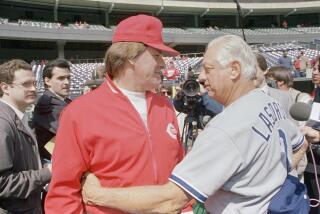MLB takes hardball out of baseball
In the bottom of the 12th inning during Major League Baseballâs All-Star Game in 1970, a spectacular collision took place at home plate. The National Leagueâs Pete Rose smashed into American League catcher Ray Fosse, hurling him backward into the dirt. Rose scored the winning run, while Fosse suffered a career-threatening injury. It was one of the most exciting moments in All-Star history.
In February, Major League Baseball announced an experimental one-year change â Rule 7.13 â designed to reduce the chances that either a catcher or runner would be injured in an âegregiousâ collision at home plate. Under the new rule, a runner may not veer from a direct line to the plate in order to knock over the catcher, and the catcher may not block the runnerâs path to the plate if he is not holding the ball.
In their clarifying comments on the changes â designed to help umpires interpret the new rule â MLB rulemakers sounded like technical judges at an Olympic figure skating contest. A runner can be called out if he lowers his shoulder or pushes âthrough with his hands, elbows or arms.â Runners sprinting toward home must slide into the plate in an âappropriate manner,â and if sliding feet first, the âbuttocks and legs should hit the ground before contact with the catcher.â
The Dodgers might have to spend most of spring training explaining to Yasiel Puig â who canât seem to slow down â what all this actually means.
When Rose heard about the proposed rule change, he asked a reporter, âWhatâs the game coming to?â and wondered whether they would soon outlaw breaking up the double play. Rose, despite having his own difficulty obeying rules, was suggesting that the game itself shouldnât be changed without careful thought.
Baseball is a game of complex rules and exacting dimensions. Altering one key element â such as the height of the pitcherâs mound, for instance â can affect every other element.
Online chatter about the rule change has been widespread and passionate. Many fans are expressing concern not merely with this particular rule but with how a moment in the game when courage is demonstrated â the raw encounter between the runner and the catcher â might be lost.
For example, when a batter refuses to yield his position in the batterâs box after a pitcher throws the ball high and tight at 95 mph, the batter is signaling that he wonât be intimidated. And a catcher standing his ground when a runner is barreling down the line at him requires a brave spirit that becomes part of a ballplayerâs character.
My mother, Helen, and brother Casey were professional baseball players who often told me that risking their bodies to benefit their team was required to play the game well. The most prominent picture in Caseyâs memorabilia room is of him bowling over Chicago Cubs catcher Damon Berryhill and jarring the ball loose.
Casey, who now coaches baserunning and fielding in the Texas Rangers farm system, says he understands why they are altering the rule but wonders about its impact.
âSo you canât use your shoulder anymore. What does a runner do, hit the catcher with his chest?â
In professional baseball today, risking injury for the sake of the team may be considered naive. Players are understandably concerned about hurting their careers. Owners donât want their âinvestmentsâ damaged, and coaches want a team that stays healthy and wins.
Self-interest would seem to dictate easing up when chasing a fly ball to avoid running into the fence, or stepping away from a runner heading for the plate so you donât get creamed.
Maybe itâs a good rule and injuries might be reduced. But Iâm afraid something ineffable will be lost as well. Baseball is and should be a messy, unpredictable and split-second game, especially during plays at the plate.
Iâll greet the new season with the same joy and optimism as always, and Iâll be at Dodger Stadium on opening day. Maybe Iâll splurge and buy a seat up close so I can watch any contested play at the plate in the bottom of the ninth. I want to hear Dodgers Manager Don Mattingly when he runs at the umpire, gets in his face and yells, âHis buttocks and legs were on the ground during the slide.â Maybe Iâll get used to it.
Kelly Candaele produced the documentary âA League of Their Own,â about his motherâs and auntâs years in the All American Girlâs Professional Baseball League, and wrote the story for the film of the same name.
More to Read
A cure for the common opinion
Get thought-provoking perspectives with our weekly newsletter.
You may occasionally receive promotional content from the Los Angeles Times.










